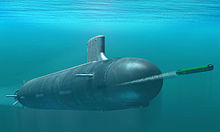Single hull boat

A single-hulled boat is a submarine in which the pressure hull of the submarine is identical to the hull. Single - hulled boats differ significantly from the so - called double - hulled boats . At the beginning of the first trials and tests with underwater vehicles, these were all built as single-hulled boats . Towards the middle / end of the 19th century, due to technical progress, they were finally replaced by the two-hulled boats, which were mainly used in the First and Second World Wars . After the end of the Second World War, however, the two-hulled boats were gradually replaced by single-hulled boats with a hydrodynamically optimized hull shape .
Single-hull boats are characterized by the fact that in these boats the diving cells are attached inside the pressure hull . However, since the diving cells are in contact with the surrounding water, they must be built pressure-resistant or appropriate pumps must be available.
The first underwater vehicles from the 15th to 18th centuries were all single-hulled boats . Almost without exception, they were made of wood and - if at all - only held together by iron frames or nails. The boats were often made in such a way that another wooden boat was symbolically mounted up the keel on a normal wooden boat. As a rule, the wooden frames of such underwater vehicles were sealed with pitch and additionally covered completely with a skin made of leather for sealing. These boats thus consisted of only one shell. Due to the growing demands on the submarines in terms of stability and seaworthiness, it became necessary to revise the shape of the hull and the construction of the ship. Since the U-boats were moving at the beginning of the 20th century primarily over water and only attack and escape purposes on diving trip went, they were also optimized primarily for surface running. This development led to the two-hulled boats.
With the increasing technical development after or during the Second World War, however, the surface aspect of the submarines gradually disappeared. The two-hulled boat was initially given a hydrodynamically clean, smooth shape, and American developments around the test submarine USS Albacore eventually led back to the single-hulled boat in the teardrop shape that is predominantly built today.